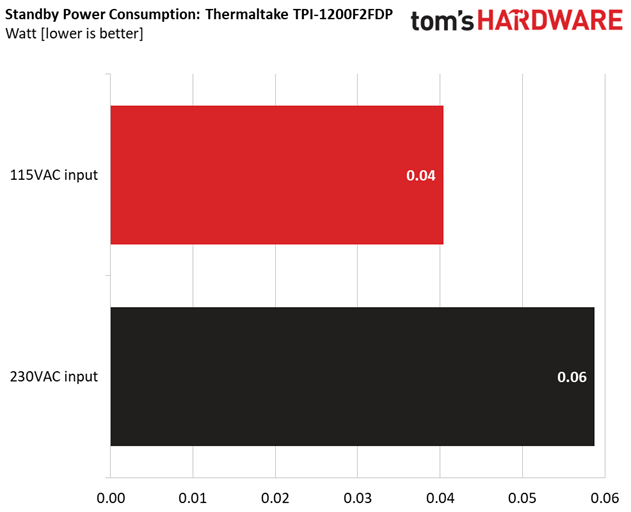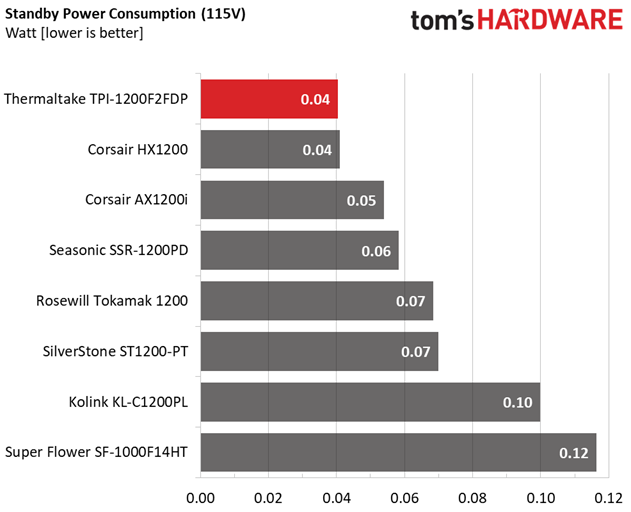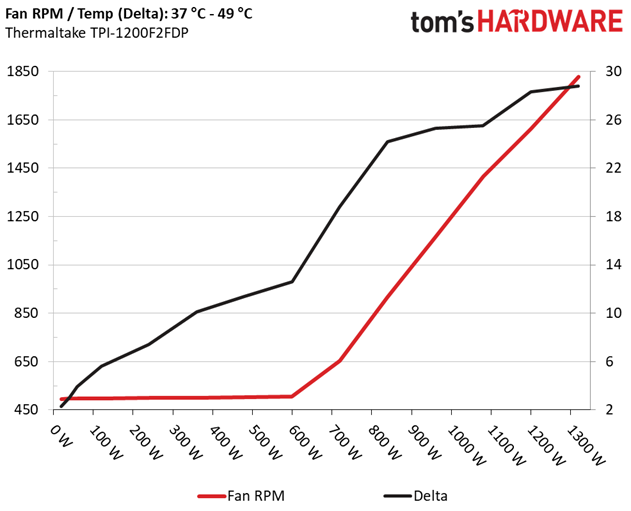Thermaltake Toughpower iRGB Plus 1200W Platinum PSU Review
Why you can trust Tom's Hardware
Efficiency, Temperature & Noise
Efficiency
Our efficiency testing procedure is detailed here.
Using results from the previous page, we plotted a chart showing the TPI-1200F2FDP's efficiency at low loads, and loads from 10 to 110 percent of its maximum-rated capacity.




Compared to other Platinum-class platforms, the TPI-1200F2FDP doesn't seem to be particularly competitive under light and normal loads.
Efficiency At Low Loads
In the following tests, we measure the TPI-1200F2FDP's efficiency at loads significantly lower than 10 percent of its maximum capacity (the lowest load the 80 PLUS standard measures). The loads we dialed were 20, 40, 60, and 80W. This is important for representing when a PC is idle, with power-saving features turned on.
| Test # | 12V | 5V | 3.3V | 5VSB | DC/AC (Watts) | Efficiency | Fan Speed | PSU Noise | PF/AC Volts |
|---|---|---|---|---|---|---|---|---|---|
| 1 | 1.217A | 0.489A | 0.479A | 0.196A | 19.675 | 54.464% | 495 RPM | 8.8 dB(A) | 0.858 |
| 12.013V | 5.058V | 3.321V | 5.054V | 36.125 | 115.10V | ||||
| 2 | 2.457A | 0.980A | 0.990A | 0.395A | 39.765 | 70.975% | 496 RPM | 8.8 dB(A) | 0.927 |
| 12.017V | 5.058V | 3.321V | 5.050V | 56.027 | 115.10V | ||||
| 3 | 3.697A | 1.476A | 1.503A | 5.047A | 59.873 | 78.261% | 497 RPM | 8.8 dB(A) | 0.943 |
| 12.019V | 5.058V | 3.320V | 5.047V | 76.504 | 115.10V | ||||
| 4 | 4.927A | 1.974A | 1.986A | 0.791A | 79.784 | 82.188% | 497 RPM | 8.8 dB(A) | 0.965 |
| 12.019V | 5.058V | 3.320V | 5.043V | 97.075 | 115.10V |
It's possible that the power consumption of Thermaltake's MCUs is responsible for such low efficiency under light loads. Even a few watts makes a huge difference in these results.
5VSB Efficiency
The ATX specification, along with CEC, ErP Lot 3 2014 and ErP Lot 6 2010/2013, states that 5VSB standby supply efficiency should be as high as possible, recommending 75 percent or higher with 550mA, 1A, and 1.5A of load. The PSU should also achieve higher than 75% efficiency at 5VSB under full load, or with 3A if its max current output on this rail is higher than 3A.
We take six measurements: one each at 100, 250, 550, 1000, and 1500mA, and one with the full load the 5VSB rail can handle.
Get Tom's Hardware's best news and in-depth reviews, straight to your inbox.
| Test # | 5VSB | DC/AC (Watts) | Efficiency | PF/AC Volts |
|---|---|---|---|---|
| 1 | 0.102A | 0.506 | 74.412% | 0.066 |
| 4.981V | 0.680 | 115.05V | ||
| 2 | 0.252A | 1.255 | 77.231% | 0.149 |
| 4.978V | 1.625 | 115.05V | ||
| 3 | 0.542A | 2.697 | 77.880% | 0.270 |
| 4.972V | 3.463 | 115.05V | ||
| 4 | 1.002A | 4.975 | 77.288% | 0.382 |
| 4.963V | 6.437 | 115.06V | ||
| 5 | 1.502A | 7.440 | 77.315% | 0.442 |
| 4.954V | 9.623 | 115.06V | ||
| 6 | 3.002A | 14.779 | 76.834% | 0.506 |
| 4.923V | 19.235 | 115.06V |


The 5VSB rail offers decent efficiency, but we frankly expected higher efficiency levels from this platform.
Power Consumption In Idle And Standby
In the table below, you'll find the power consumption and voltage values of all rails (except -12V) when the PSU is idle (powered on, but without any load on its rails), and the power consumption when the PSU is in standby mode (without any load, at 5VSB).
| Mode | 12V | 5V | 3.3V | 5VSB | Watts | PF/AC Volts |
|---|---|---|---|---|---|---|
| Idle | 12.011V | 5.059V | 3.322V | 5.057V | 17.580 | 0.663 |
| 115.1V | ||||||
| Standby | 0.040 | 0.004 | ||||
| 115.1V |


Vampire power is amazingly low using both voltage inputs.
Fan RPM, Delta Temperature, And Output Noise
Our mixed noise testing is described in detail here.
The first chart below illustrates the cooling fan's speed (in RPM), and the delta between input and output temperature. The results were obtained at 37°C (98.6°F) to 49°C (120.2°F) ambient temperature.
The next chart shows the cooling fan's speed (again, in RPM) and output noise. We measured acoustics from one meter away, inside a hemi-anechoic chamber. Background noise inside the chamber was below 6 dB(A) during testing (it's actually much lower, but our sound meter’s microphone hits its floor), and the results were obtained with the PSU operating at 37°C (98.6°F) to 49°C (120.2°F) ambient temperature.
The following graph illustrates the fan's output noise over the PSU's operating range. The same conditions of the above graph apply to our measurements, though the ambient temperature was between 30°C (86°F) to 32°C (89.6°F).
The fan profile is relaxed, as you can see in the graph above. Under 30-32°C ambient and up to 600W load, the PSU is nearly silent. It needs about 890W of load for the fan to start making its presence felt. With over 1100W, the fan becomes quite a bit louder.
MORE: Best Power Supplies
MORE: How We Test Power Supplies
MORE: All Power Supply Content
Current page: Efficiency, Temperature & Noise
Prev Page Load Regulation, Hold-Up Time & Inrush Current Next Page Protection Features
Aris Mpitziopoulos is a contributing editor at Tom's Hardware, covering PSUs.
-
pjmelect Your videos don't work I get the error "cannot load m3u8 crossdomain access denied (2048)"Reply -
Co BIY Everyone reviews heavily on capacitor quality but how is cap quality determined ? Is it published specs or just reputation / country of origin ?Reply
The bad cap crisis was over ten years ago are all those makers
still putting out bad or inconsistent products ? -
Aris_Mp The videos work fine for me.Reply
Caps: Mostly based on experience and the RMA data that I have access to. The quality of the electrolyte is what matters the most. -
Mike Adams CapXon & Su'scon caps? more chinese junk for a premium price. I would never buy anything from ThermalsewerReply


